2014 AUDI RS7 SPORTBACK warning
[x] Cancel search: warningPage 139 of 292
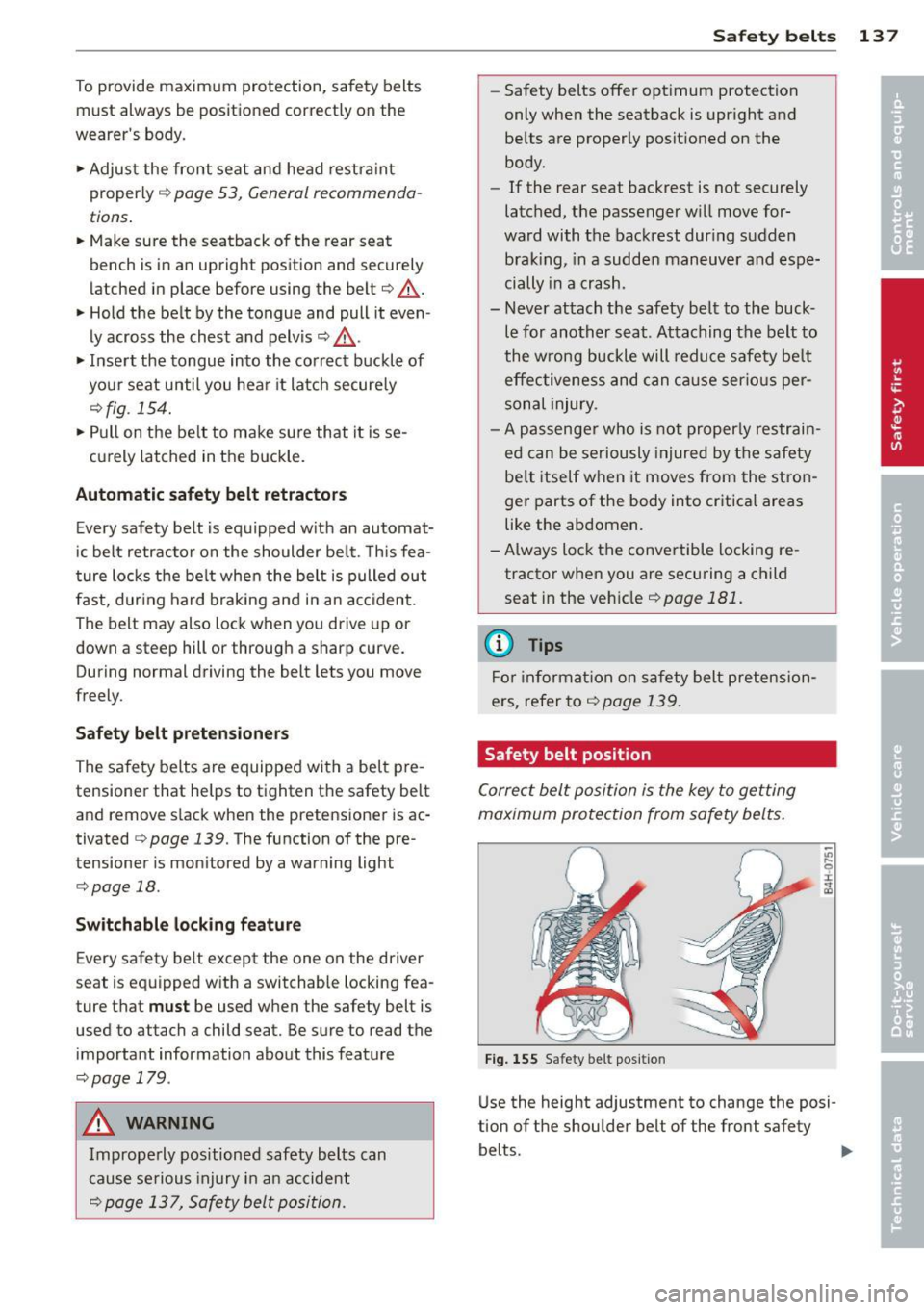
To provide maximum protection, safety belts
must always be positioned correctly on the
wearer's body .
... Adjus t the front seat and head restraint
properly
c::> page 53, General recommenda
tions .
... Make sure the seatback of the rear seat
bench is in an upright position and securely
latched in place before using the belt
c::> ,&. .
... Hold the be lt by the tongue and pull it even
ly across the chest and pelvis
c::> ,&..
... Insert the tongue into the co rrect buckl e of
your seat until you hea r it latch securely
c::>fig . 154.
... Pull on the belt to make sure that it is se-
curely latched in the buckle.
Automatic safety belt retractors
Every safety belt is equipped w ith an automat
i c belt retractor on the shoulder be lt. T his fea
ture locks the belt when the belt is pulled out
fast, dur ing hard braking and in an accident.
The belt may also lock when you drive up or
down a steep hill or through a sharp curve.
During normal driving the belt lets you move
freely.
Safety belt pretensioners
The safety belts are equipped with a belt pre
tensioner that helps to tighten the safety belt
and remove slack when the pretensioner is ac
tivated
c::> page 139. The function of the pre
tensioner is mon itored by a warning light
c::> page 18 .
Switchable locking feature
Every safety belt except the one on the driver
seat is equipped w ith a switchable locking fea
ture that
must be used when the safety belt is
used to attach a child seat. Be sure to read the
important information about this feature
c::> page 179.
A WARNING
Improperly positioned safety belts can
cause se rious injury in an accident
c::> page 13 7, Safety belt position.
Safety belts 13 7
-Safety belts offer optimum protection
only when the seatback is upright and
be lts are properly posit ioned on the
body .
- If the rear seat backrest is not securely
latched, the passenger will move for
ward with the backrest during sudden braking, in a sudde n maneuver and espe
cially in a crash.
- Never attach the safety belt to the buck
l e for another seat . Attaching the belt to
the wrong buckle will reduce safety be lt
effec tiveness and can cause serious per
sonal injury.
- A passenge r who is not properly restrain
ed can be seriously injured by the sa fety
be lt itself when it moves from the stron
ger parts of the body into critical areas
like the abdomen.
- Always lock the conve rtible locking re
tractor when you are securing a child seat in the veh icle
~ page 181.
(D Tips
For info rmat ion on safety belt pretension
e rs, refer to
c::> page 139.
Safety belt position
Correct belt position is the key to getting
maximum protection from safety belts .
Fig. 155 Safe ty belt posit ion
Use the height adjustment to change the posi
tion of the shoulder belt
of the front safety
belts.
~
Page 140 of 292
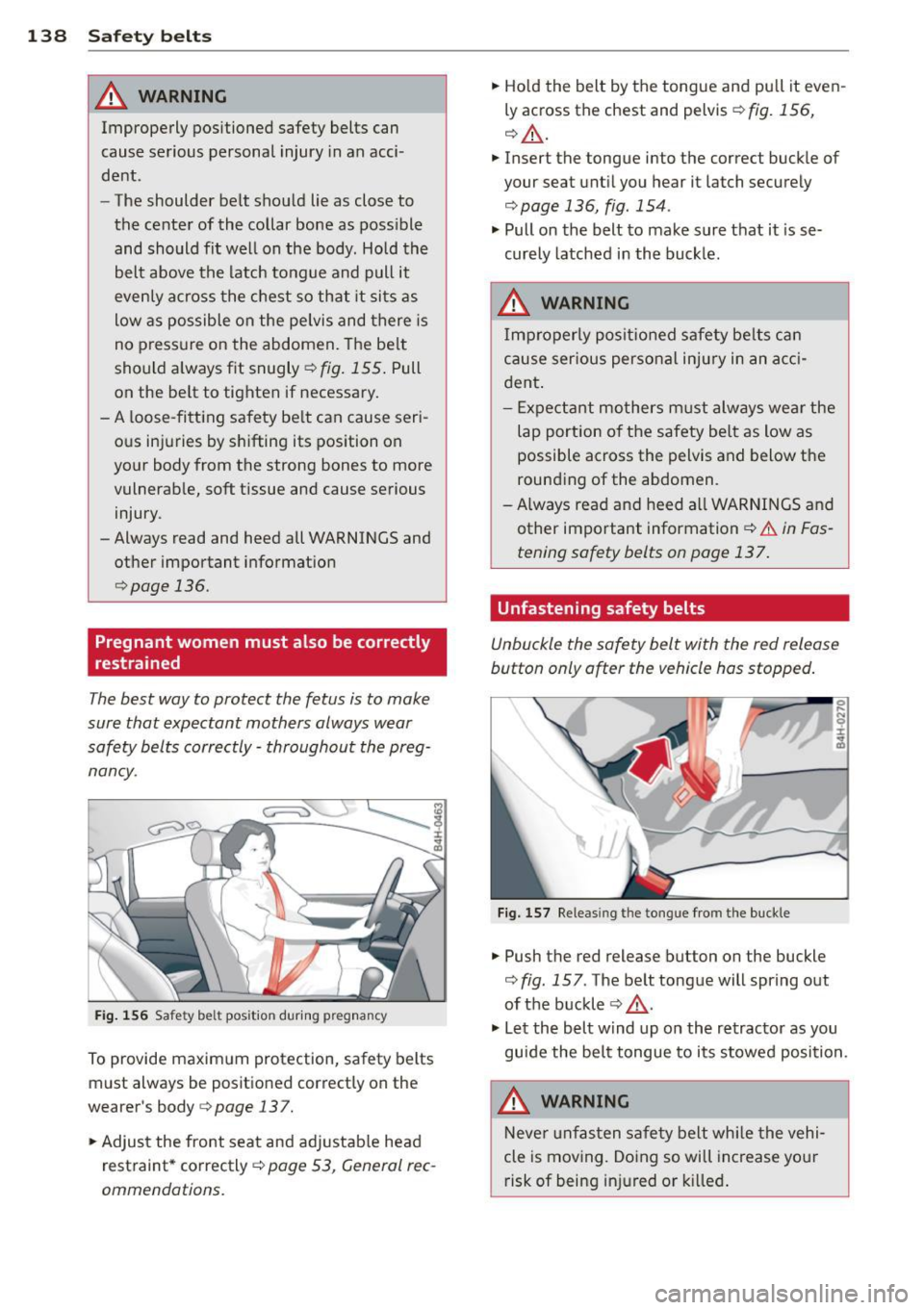
138 Safety belts
& WARNING
Improperly positione d safety belts can
cause serious personal injury in an acci
dent.
- The shoulder belt should lie as close to
the center of the collar bone as possible
and should fit well on the body. Hold the
belt above the latch tongue and pull it
evenly across the chest so that it sits as
low as possible on the pelvis and there is
no pressure on the abdomen. The belt
should always fit snugly¢
fig. 155. Pull
on the belt to tighten if necessary.
-A loose-fitting safety belt can cause seri
ous injuries by shifting its position on
your body from the strong bones to more
vulnerable, soft tissue and cause serious injury.
-Always read and heed all WARNINGS and
other important information
¢page 136.
Pregnant women must also be correctly
restrained
The best way to protect the fetus is to make
sure that expectant mothers always wear safety belts correctly -throughout the preg
nancy.
Fig. 156 Safety belt position during pregnancy
To provide maximum protection, safety belts
must always be positioned correctly on the
wearer's body
¢ page 137.
"'Adjust the front seat and adjustable head
r estraint * correctly ¢
page 53, General rec
ommendations.
"'Hold the belt by the tongue and pull it even
ly across the chest and pelvis¢
fig. 156,
¢ _&..
"' Insert the tongue into the correct buckle of
your seat until you hear it latch securely
¢page 136, fig. 154.
"' Pull on the belt to make sure that it is se
curely latched in the buckle.
& WARNING
Improperly positioned safety belts can
cause serious personal injury in an acci
dent.
-
- Expectant mothers must always wear the
lap portion of the safety belt as low as
possible across the pelvis and below the
rounding of the abdomen.
- Always read and heed all WARNINGS and
other important information¢.&.
in Fas
tening safety belts on page 137.
Unfastening safety belts
Unbuckle the safety belt with the red release
button only after the vehicle has stopped.
Fig. 157 Releas ing the tongue from the buckle
"' Push the red release button on the buckle
¢ fig. 157. The belt tongue will spring out
of the buckle
¢ ,& .
"' Let the belt wind up on the retractor as you
guide the belt tongue to its stowed position.
& WARNING
Never unfasten safety belt while the vehi
cle is moving. Doing so will increase your
risk of being injured or killed.
Page 141 of 292
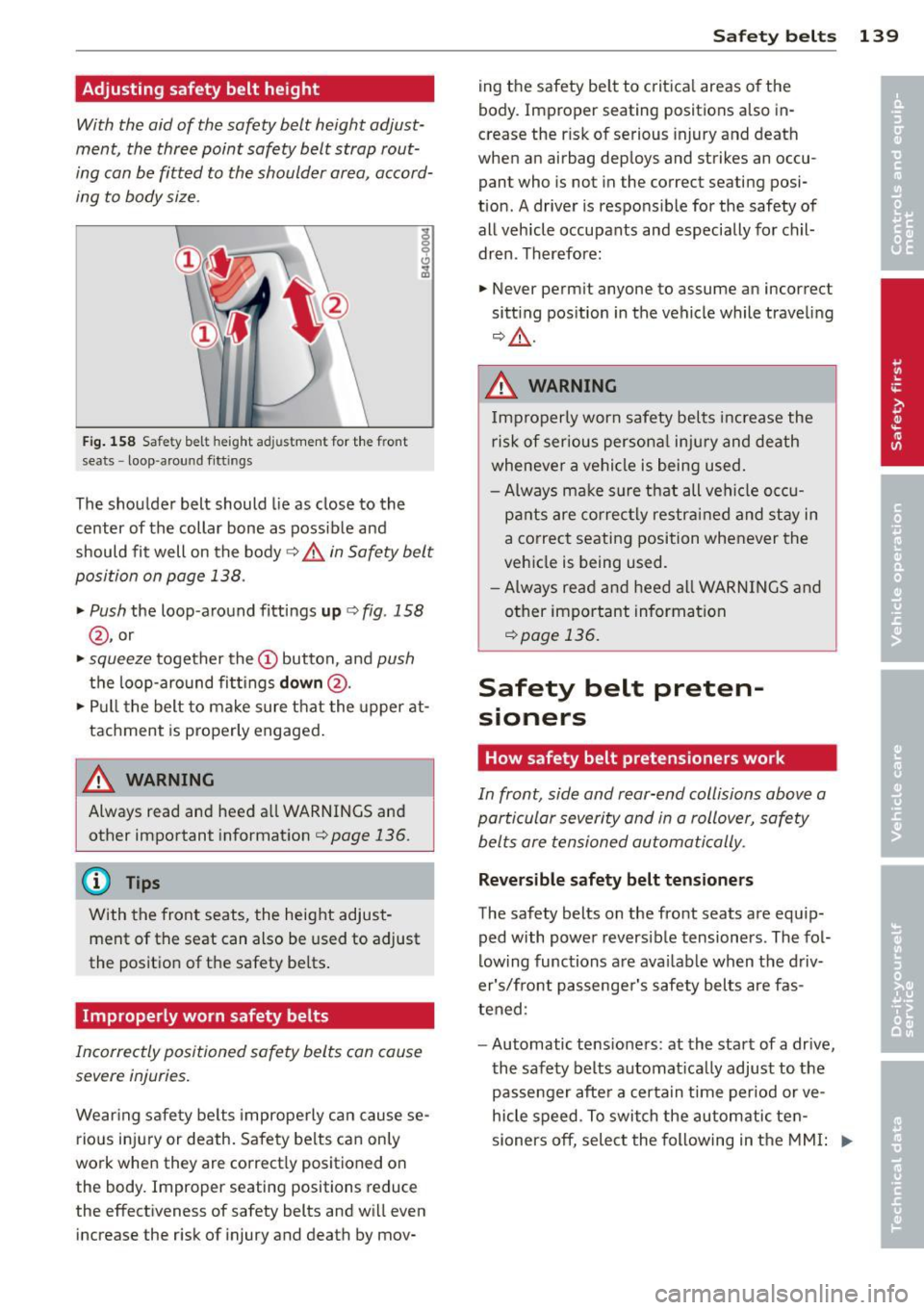
Adjusting safety belt height
With the aid of the safety belt height adjust
ment, the three point safety belt strap rout
ing can be fitted to the shoulder area, accord
ing to body size .
Fig . 158 Saf ety belt he ight ad justment for the front
seats -loop -aro und f itt ings
The shoulder belt should lie as close to the
center of the collar bone as possib le and
should fit well on the body¢,&.
in Safety belt
position on page 138 .
.,. Push
the loop -a round fittings up c> fig . 158
@ , or
.,. squeeze together the@button, and push
the loop-around fi ttings down @.
.,. Pull the belt to make sure t hat the upper at
tachment is properly engaged .
A WARNING
Always read and heed all WARNINGS and
other important informat ion
c> page 136 .
@ Tips
With the front seats, the height adjust
ment of the seat can also be used to adjust
the posit ion of the safety be lts .
Improperly worn safety belts
Incorrectly positioned safety belts can cause
severe injuries.
Wear ing safety be lts improperly can cause se
rio us in jury or death. Safety belts ca n only
work when they are correct ly positioned on
the body. Improper seating positions reduce the effectiveness of safety belts and wi ll even
increase the r isk of injury and death by mov-
Safety belts 139
ing the safety be lt to critica l areas of the
body. Improper seat ing positions also in
crease the r isk of serious injury and death
when an airbag dep loys and strikes an occu
pant who is not in the correct seating posi
tion . A driver is respons ible for the safety of
all vehicle occupants and especially for ch il
dren . Therefore:
.,. Never perm it anyone to assume an incorrect
sitt ing pos ition in the vehicle while trave ling
~ .&. -
A WARNING
Imp roperly worn safety belts increase the
risk of serious persona l injury and death
whenever a vehicle is being used.
- Always ma ke s ure that all vehi cle occu
pa nts are co rrec tly restra ined and stay in
a correct seating position whenever the
veh icle is being used .
- Always read and heed al l WARNI NGS a nd
other important informat ion
r:::> page 136 .
Safety belt preten
sioners
How safety belt pretensioners work
In front, side and rear-end collis ions above a
particular severity and in a rollover, safety
belts are tensioned automati cally .
Reve rsible s afety belt tensioners
The safety belts on the front seats are equ ip
ped with powe r reversible tensioners . The fol
low ing functions a re ava ilab le when the driv
er's/front passenge r's safety belts are fas
tened :
- Automatic tens ioners : at the start of a drive,
the saf ety belts automat ica lly adjust to the
passe nger afte r a certa in time per iod or ve
hicle speed . To switch the automatic ten
sioners off, select the following in the MMI: .,..
Page 142 of 292
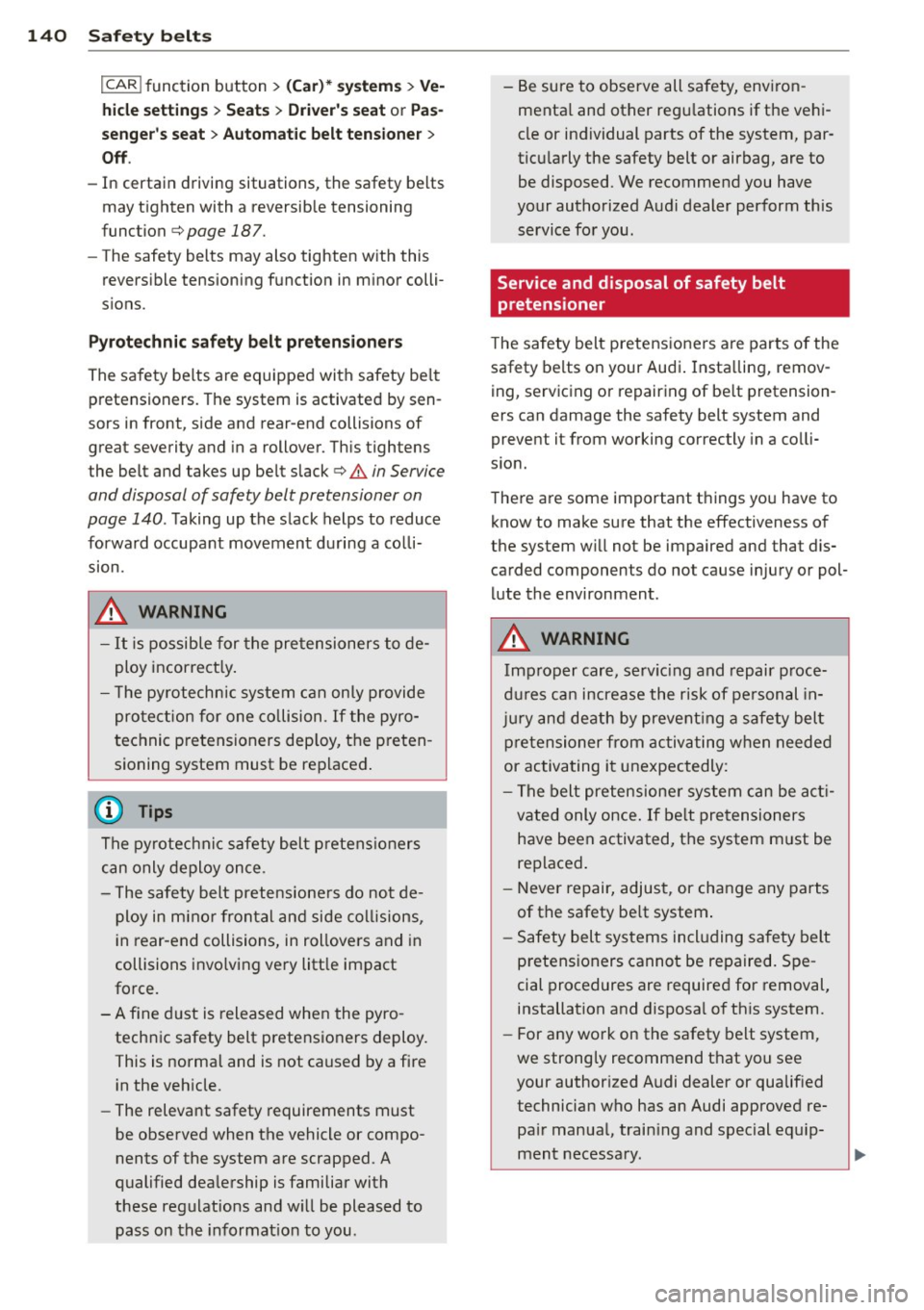
140 Safety belts
ICAR !function button> (Car )* sys tem s> Ve
hicle setting s > Seats > Driver 's seat or Pas
senger 's se at > Automatic belt ten sioner
>
Off .
-In certain driving situations, the safety be lts
may tighten with a reversib le tensioning
function
c:> page 187.
- The safety belts may also tighten with this
revers ible tensioning f unction in m inor colli
s ions.
Pyrotechnic safety belt preten sioner s
The sa fety belts are equipped with safety be lt
pretensioners. The system is activated by sen
sors in front, side and rear-end collisions of
great severity and in a rollover. Th is tightens
the belt and takes up be lt slack
c:> &. in Service
and disposal of safety belt pretensioner on
page 140 .
Taking up the slack helps to reduce
forward occupant movement during a co lli
sion.
,& WARNING
- It is possib le for the pre tensioners to de
ploy incorrect ly .
- T he py rotechnic system can only pr ovide
pro te ction for one co llision.
If t he pyro
techni c pretensioners dep loy, the p reten
sioning system must be replaced .
@ Tips
The pyrotechnic safety belt p retens ioners
can only deploy once .
- The safety belt pretens ione rs do no t de
ploy in mi no r frontal an d side col lisions,
i n rear -end collisions, in rollove rs and in
collisions invo lving very litt le impact
fo rce.
- A f ine d ust is released when the pyro
technic safety belt pretensioners deploy.
This is normal and is not caused by a fire
i n the veh icle.
- The relevant safety requirements must
be observed when the vehicle or compo
nents of the system are scrapped. A
qualified dea lership is familiar with
these regulations and w ill be pleased to
pass on the informat io n to you . - Be sure to observe all safety, env
iron
menta l and other regu lations if the ve hi
cle or individual parts of the system, par
ticu larly the safety belt or airbag, are to
be disposed. We recommend you have
your authorized Audi dealer perform this service fo r you.
Service and disposal of safety belt
pretensioner
T he safety belt pretens ioners are parts o f the
safety belts on your Audi . Insta lling, remov
ing, servicing or repairing of be lt pretension
ers can damage the safety belt system and
prevent it from working correctly in a co lli
s ion.
There are some important t hings you have to
know to make sure that the effectiveness of
the system w ill not be impaired and that dis
carded components do no t cause injury or pol
l u te the environment .
A WARNING
-Improper care, serv ic ing and repair p roce-
d ur es can increase the risk of pe rsonal in
j u ry and death by prevent ing a safety belt
p retensioner from activ ating w hen neede d
or activa ting it unexpectedly:
- T he belt pretensione r system can be a ct i
vated only once. If be lt pretensioners
have been activated , the system m ust be
replaced .
- Never repair, adjus t, or change any parts
of the safety be lt system .
- Safety belt systems incl uding safety belt
pretensioners cannot be repaired. Spe
cial procedures are required for removal,
installation and disposa l of th is system.
- For any wo rk on the safety belt system,
we strongly recommend t hat you see
your author ized Audi dealer or qualif ied
technician who has an Audi approved re pa ir manua l, train ing and special equ ip
ment necessary.
Page 145 of 292
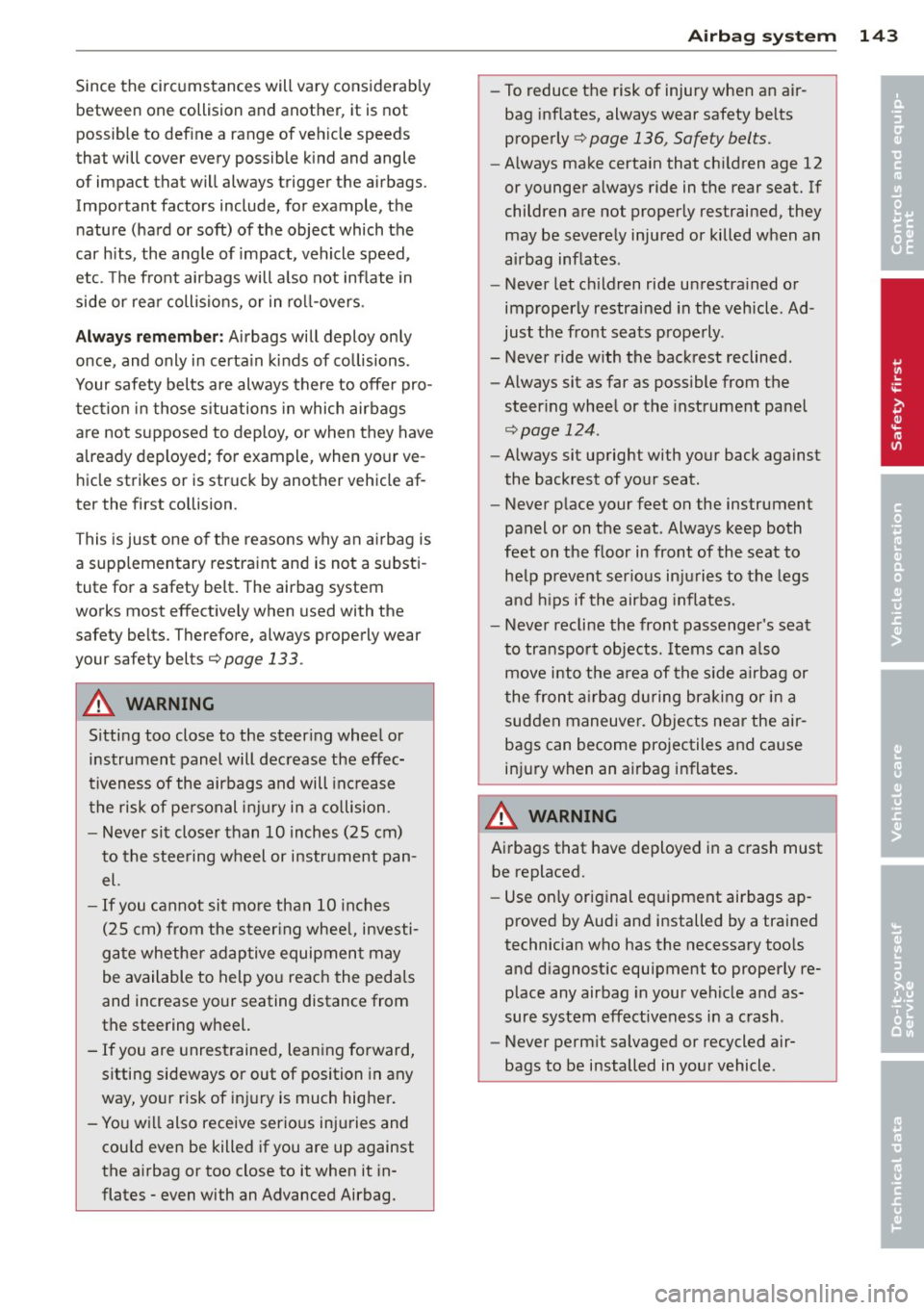
Since the circumstances will vary considerably
between one collision and another , it is not
possible to define a range of veh icle speeds
that will cover every possible k ind and angle
of impact that will always trigger the airbags .
Important factors include, for example, the nature (hard or soft) of the object which the
car h its, the ang le of impact, vehicle speed ,
etc. The front airbags will a lso not inflate in
side or rear collisions, or in ro ll-overs .
Alw ays rememb er: Airbags will deploy only
once, and only in certa in kinds of collisions.
Your safety belts are always there to offe r pro
tect ion in those s ituations in which airbags
are not supposed to deploy , or when they have
a lready deployed ; for example , when your ve
hicle strikes or is struck by another vehicle af
ter the first co llision .
This is just one of the reasons why an a irbag is
a supp lementary restraint and is not a s ubsti
tute for a safety belt . The airbag system
works most effectively when used with the
safety belts. Therefore, always properly wear
your safety belts ¢
page 133.
A WARNING
Sitting too close to the steer ing whee l or
instrument panel will decrease the effec
tiveness of the airbags and will inc rease
the risk of pe rsonal injury in a co llision .
- Never sit closer than 10 inches (2S cm)
to the stee ring wheel or instr ument pan
el.
- If you cannot sit more than 10 inches
( 2 5 cm) from the steer ing whee l, investi
ga te whethe r adaptive equipment may
be available to help you reach the pedals
and increase your seating distance from
the steering wheel.
- If you are unrestrained, lean ing forward,
sitting sideways or out of position in any
way, yo ur risk of inj ury is much higher.
- You w ill also receive serio us injuries and
cou ld even be killed if you are up against
the a irbag or too close to it when it in
flates -even with an Advanced Airbag.
A irbag system 143
-To reduce the risk of injury when an air
bag inflates, always wear safety belts
properly ¢
page 136, Safety belts.
-Always make certain that ch ild ren age 12
or younger a lways ride in the rear seat. If
children are not properly restrained, they may be severe ly injured or killed when an
airbag inf lates .
- Never let ch ildren ride unrestra ined or
improperly restrained in the vehicle. Ad
just the front seats prope rly .
- Never ride with the backrest reclined .
- Always sit as far as possible from the
steer ing whee l or the instrument pane l
¢page 124.
-Always sit upright with your back against
the backrest of your seat .
- Never p lace your feet on the instrument
panel or on the seat. Always keep both
feet on the f loor in front of the seat to
he lp preven t serio us in ju ries to the legs
and h ips if the airbag infla tes.
- Never recline the front passenger 's seat
to transport objects . Items can a lso
move into the area of the s ide a irbag or
the front a irbag du ring bra king or in a
sudden maneuve r. Obje cts near the air
bags can become projectiles and cause
in ju ry when an airbag inflates.
A WARNING
Airbags that have deployed in a crash must
be replaced.
- Use on ly original equipment airbags ap
proved by Aud i and installed by a trained
technician who has the necessary too ls
and d iagnost ic equipment to properly re
place any airbag in your vehicle and as
sure system effectiveness in a crash .
- Never perm it salvaged or recycled air
bags to be installed in your vehicle . •
•
Page 146 of 292
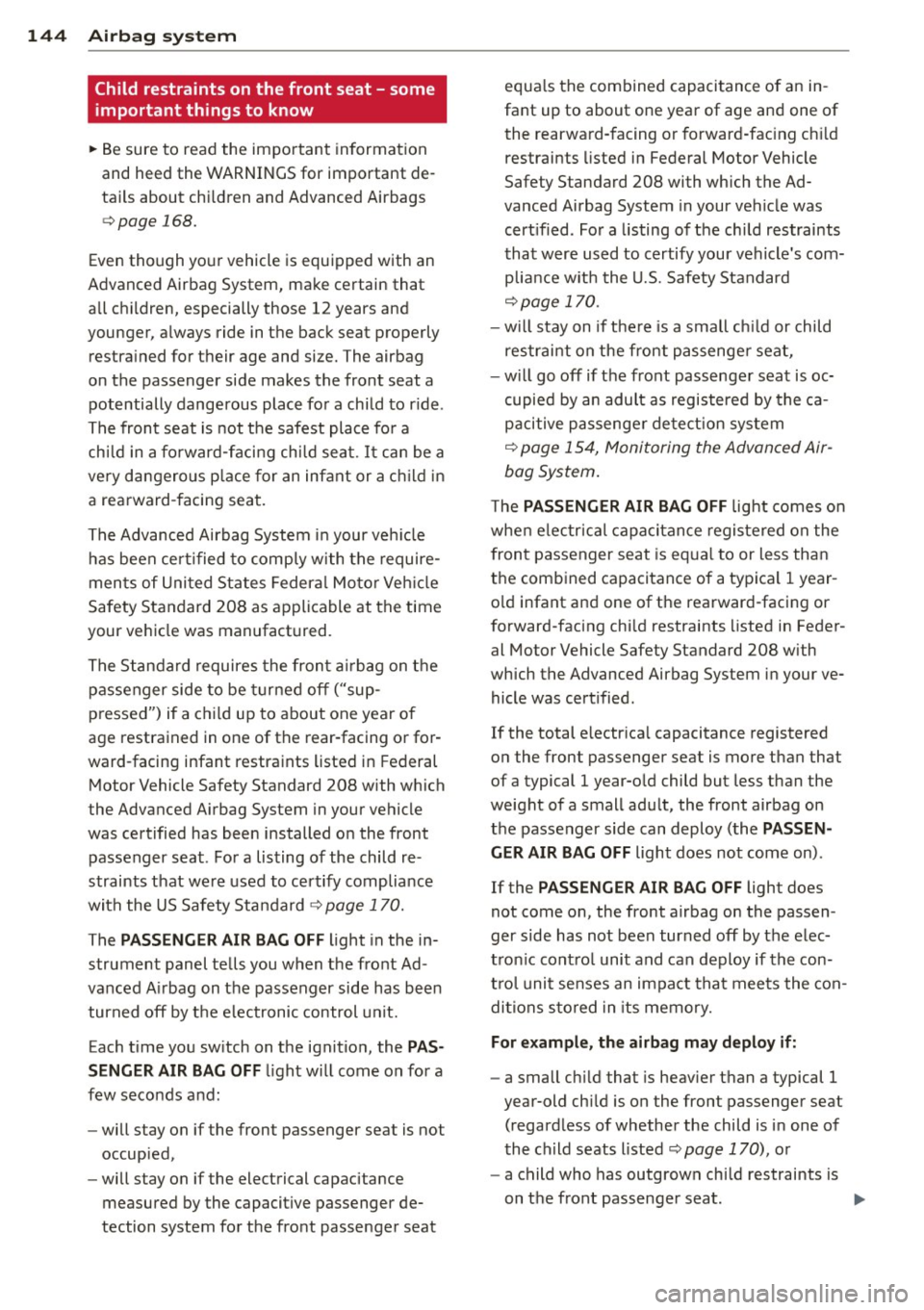
144 Airbag sys tem
Child restraints on the front seat - some
important things to know
• Be sure to read the important information
and heed the WARNINGS for important de
ta ils about ch ildren and Advanced Airbags
i=> page 168.
Even though your vehicle is equipped with an
Advanced Airbag System, make certain that
all children, especially those 12 years and
younger, always ride in the back seat properly
restra ined for their age and size. The airbag
on the passenger side makes the front seat a potentially dangerous place for a child to r ide .
The front seat is not the safest place fo r a
chi ld in a fo rward-facing chi ld seat.
It can be a
ve ry dangerous p lace for an infant or a c hild in
a rearward -facing seat.
The Advanced Airbag System i n your veh icle
has been certified to comply with the require
men ts of United States Federa l Mo to r Veh icle
Safety Standard 208 as applicable at the time
your ve hicle was manufact ured.
The Standa rd requires the fron t air bag on t he
passenger side to be turned off ("sup
p ressed") if a child up to about one yea r of
age restrained in one of the rear-facing or for
ward-facing infant restraints listed in Federal
Motor Vehicle Safety Standard 208 with which
the Advanced A irbag System in your vehicle
was certified has been installed on the front
passenger seat. For a listing of the child re
straints that we re used to certify compliance
with the US Safety Sta ndard
c> page 170.
The PASSENGER AIR BAG OFF light in the in
strument panel tells you when the front Ad
vanced A irbag on the passenger side has been
turned off by t he e lectronic control unit.
Each time you sw itch on the ignit ion, the
PAS
SENGER AIR BAG OFF
l ight will come on for a
few seconds a nd:
- will stay on if the front passenger seat is not
occupied,
- will stay on if the electrical capacitance
measured by the capacitive passenger de
tection system for the fro nt passenger seat equa
ls the combined capacitance of an in
fant up to about one year of age and one of
the rearwa rd-facing or forward-fac ing ch ild
restraints listed in Federal Motor Vehicle
Safety Standard 208 with which the Ad
vanced Airbag System in your vehicle was
cert ified. For a listing of the ch ild restraints
that w ere used to certify you r vehicle 's com
plia nce w it h the U.S. Safety Standard
i=>page 170.
- w ill stay on i f the re is a small c hild or child
restrai nt on the front passenge r seat,
- w ill go off if the front passenger seat is oc
cupied by an adult as registered by the ca pacitive passenge r de tection system
c> page 154, Monitoring the Advanced Air
bag System.
T he PASSENGER AIR BAG OFF light comes on
whe n electr ica l capacitance regis tered on the
front passenger seat is eq ua l to or less than
t h e comb ined capacitance of a typical 1 year
o ld infant and one of the rearward-facing or
forward-facing child restraints listed in Feder
al Motor Vehicle Safety Standard 208 with
which the Advanced Airbag System i n your ve
hicle was cert ified .
If the total e lectr ica l capacitance registered
on the front passenger seat is more than that
of a typical 1 year-old child but less than the
we ight of a small adu lt, the front airbag on
the passenger side can deploy (the
PASSEN
GER AIR BAG OFF
light does not come on).
If the
PASSENGER AIR BAG OFF light does
not come on, the front airbag on the passen
ger side has not been turned off by the e lec
t ron ic cont ro l unit and can deploy if the con
t ro l u nit se nses an impa ct that mee ts the con
di tions s to red in its memory.
For example, the airbag may deploy if:
- a small ch ild that is heav ier th an a typical 1
year-old child is on the front passenger seat
(regard less of whether the child is in one of
the ch ild seats listed
c::;, page 170), o r
- a child who has outgrown child restraints is
on the front passenger seat. ..,.
Page 147 of 292
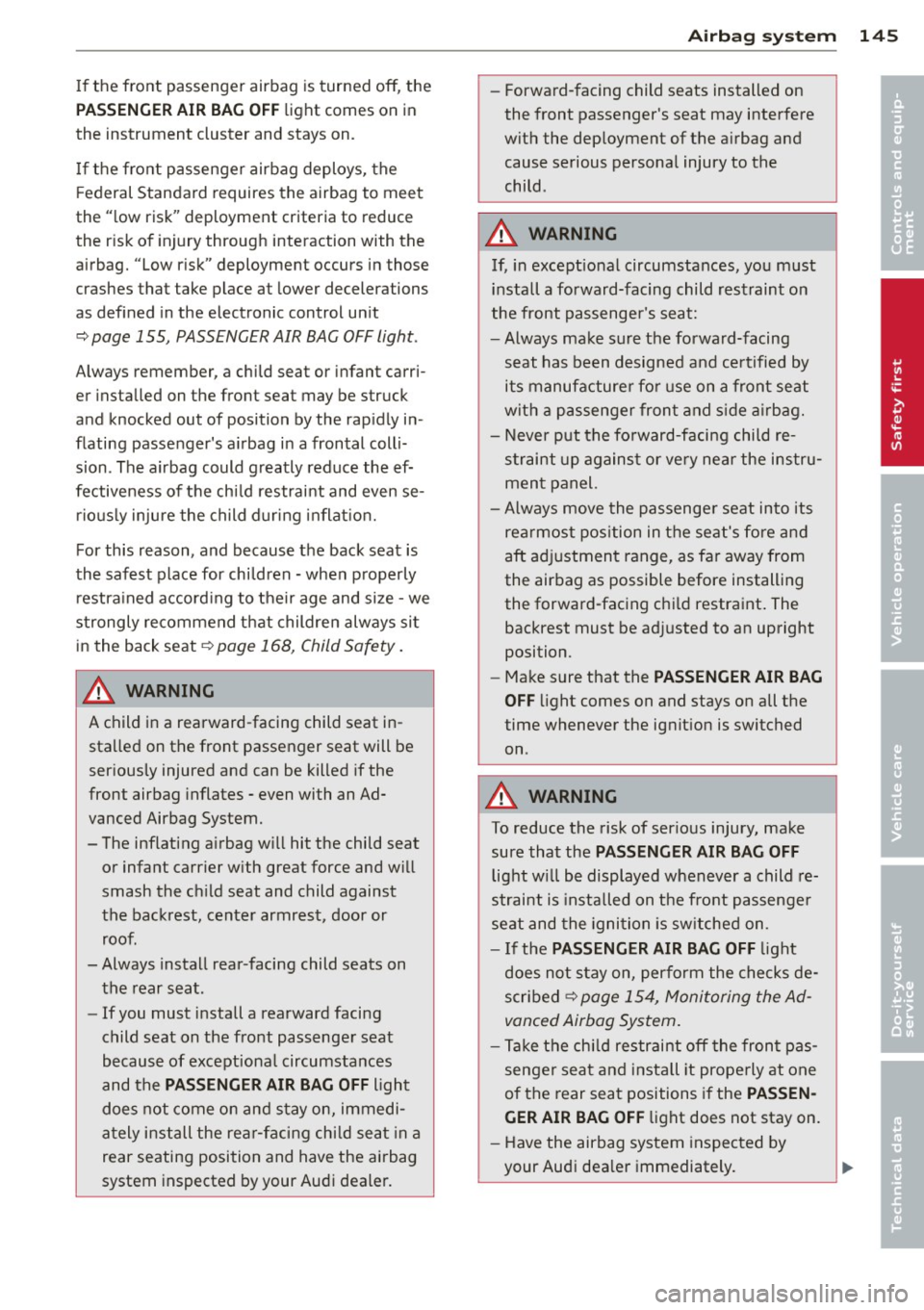
If the fron t passenger airbag is turned off, the
PA SSENGER AIR BA G OF F light comes on in
the instrument cluster and stays on.
If the front passenger airbag deploys, the
F ederal Standard requires the airbag to meet
the " low risk" deployment criteria to reduce
the r isk of injury through interaction with the
airbag. "Low r isk" deployment occurs in those
crashes that take place at lower decelerations
as defined in the electronic control un it
c::> page 155, PASSENGER AIR BAG OFF light.
Always remember, a child seat or infant carri
er installed on the front seat may be struck
and knocked out of position by the rap idly in
flating passenger's a irbag i n a frontal colli
sion . The airbag could greatly reduce the ef
fectiveness of t he ch ild restraint and even se
r io usly inju re the child d uring inflat io n.
For this reason, and because the back seat is
the safest place for chi ldren - when properly
restra ined accord ing to their age and size - we
strongly recommend that children always sit in the back seat
c::> page 168, Child Safety.
A WARNING
-
A child in a rearward -facing child seat in
stalled on the front passenger seat will be
ser iously injured and can be killed if the
front airbag inflates - even with an Ad
vanced Airbag System.
- The inflating airbag w ill hit the child seat
or infant carrier w ith great force and w ill
smash the ch ild seat and child against
the backrest, center armrest, door or roof.
- Always install rear-facing child seats on the rear seat.
- If you must install a rearward facing
child seat on the front passenge r seat
because of exceptiona l circumstances
and the
PASSENGER AIR BAG OFF light
does not come on and stay on, immedi
a tely ins tall the rea r-facing chi ld seat in a
rear seating position and have the airbag
system inspected by your Audi dealer.
A irbag system 145
-Forwa rd-facing child seats installed on
the front passenger's seat may interfere
with the dep loyment of the airbag and
cause serious persona l injury to the
child.
A WARNING
If, in except ional circumstances, you must
install a forward-facing child restraint on
the front passenge r's seat:
- Always ma ke sure the forward-facing
seat has been designed and certified by its manufacture r for use on a front seat
with a passenger fron t and s ide a irbag.
- Never put the fo rward-facing child re
s tra int up against or ve ry near the instru
men t panel.
- Always move the passenge r seat into its
rea rmost pos ition in the se at's fore and
aft ad justment range, as fa r away from
the airbag as possible before installing
the forward-fac ing ch ild restra int . The
backrest must be adj usted to an upright
position.
- Make sure that the
PASSENGER AIR BAG
OFF
li ght comes on and stays on all the
time whenever the ignition is switched on .
A WARNING
To reduce the risk of ser ious injury, make
sure that the
PASSENGER AIR BAG OFF
light w ill be displayed whenever a child re
straint is insta lled on the front passenge r
se at and the ignition is sw itched on.
- If the
PASSENGER AIR BAG OFF light
does not s tay on, perform the checks de
scribed
c::> page 154, Monitoring the Ad
vanced Airbag System.
- T ake the chi ld restraint off t he front pas
senger seat and install it prope rly at one
of the rear seat positions i f the
PASSEN
GER AIR BAG OFF
light does not stay on.
- Have the airbag system inspected by
your Aud i dea ler immediately.
•
•
Page 148 of 292
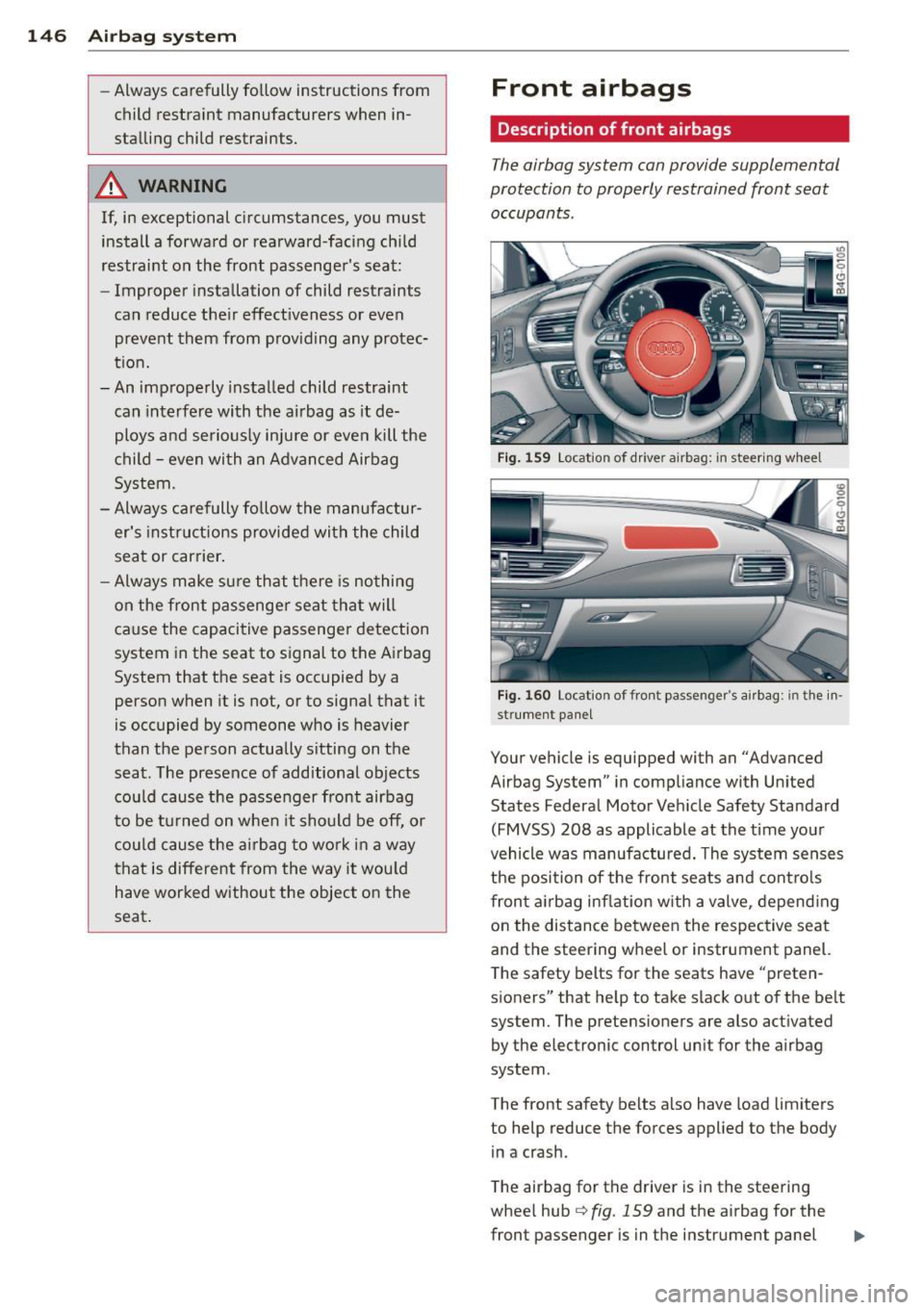
146 Airbag system
-Always carefully follow instructions from
child restraint manufacturers when in
stalling child restraints.
_& WARNING
If, in exceptional circumstances, you must
install a forward or rearward -facing child
restraint on the front passenger's seat:
- Improper installation of child restraints
can reduce their effectiveness or even
prevent them from providing any protec
tion.
- An improperly installed child restraint
can interfere with the airbag as it de
ploys and seriously injure or even kill the
child -even with an Advanced Airbag
System.
- Always carefully follow the manufactur
er's instructions provided with the child
seat or carrier .
- Always make sure that there is nothing
on the front passenger seat that will
cause the capacitive passenger detection
system in the seat to signal to the Airbag
System that the seat is occupied by a person when it is not, or to signal that it
is occupied by someone who is heavier
than the person actually sitting on the
seat . The presence of additional objects
could cause the passenger front airbag
to be turned on when it should be off, or
could cause the airbag to work in a way
that is different from the way it wou ld
have worked without the object on the
seat.
Front airbags
Description of front airbags
The airbag system can provide supplemental
protection to properly restrained front seat occupants .
Fig. 159 Locat io n of drive r ai rbag: in steering wh eel
Fig. 160 Locat io n of fron t passenger' s air bag: in the in·
st rument panel
Your vehicle is equipped with an "Advanced
Airbag System" in compliance with United
States Federal Motor Vehicle Safety Standard
(FMVSS) 208 as applicable at the time your
vehicle was manufactured. The system senses
the position of the front seats and controls
front airbag inflation with a valve , depending
on the distance between the respective seat
and the steering wheel or instrument panel.
The safety belts for the seats have "preten
sioners" that help to take slack out of the belt
system. The pretensioners are also activated by the electronic control uni t for the airbag
system .
The front safety belts also have load limiters
to help reduce the forces applied to the body in a crash.
The airbag for the driver is in the steering
wheel hub¢
fig. 159 and the airbag for the
front passenger is in the instrument panel